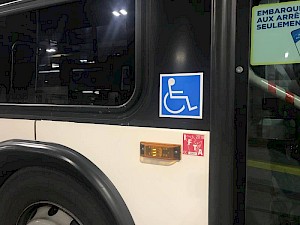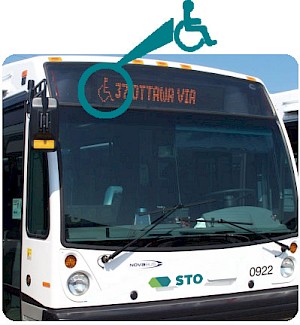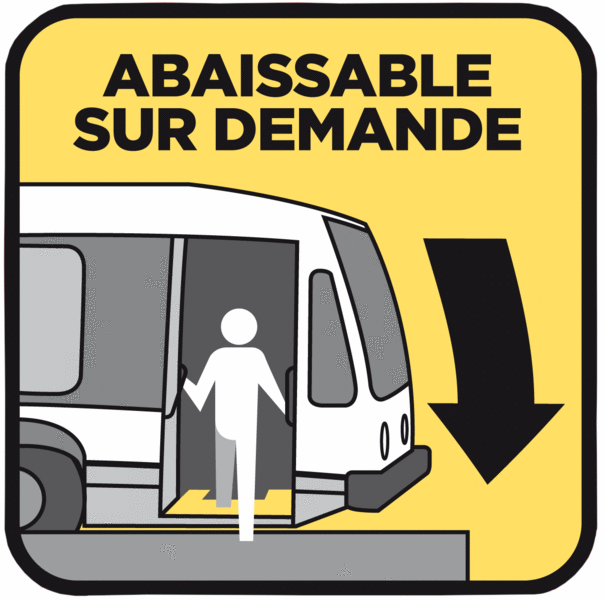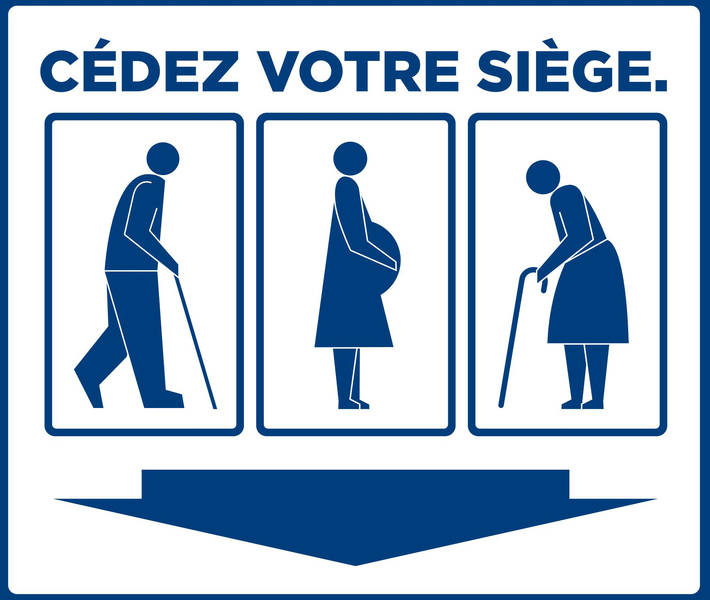Universal accessibility
We are continuing to work towards achieving an ever more accessible public transit system
Wheelchair users
You can ride any bus in the system as long as:
- the bus has an access ramp (which is the case with more than 7 out of 10 buses);
- the bus stop is accessible.
Guaranteed accessible routes
Accessibility is guaranteed when:
- All trips offered have an access ramp; and
- most of the stops are accessible, that is to say 9 out of 10.
Guaranteed accessible routes:
Monday to Friday
31 - 36 - 37 - 38 - 49 - 55 - 59 - 68 - 100 - 200 - 371 - 400
Saturday and Sunday
31 - 37 - 38 - 49 - 55 - 59 - 371 - 400
Personalized accessible itinerary with Plani-bus
You can now see accessible routes, trips and stops.
When you’re doing your search, the accessibility icon will appear next to the guaranteed accessible route, to the right of an accessible stop and next to the time when a bus with an access ramp will be stopping.
Identifying accessible stops
An access ramp can only be extended at an accessible stop.
Thus, your stop must be accessible both ways.
Accessible stops are identified by the wheelchair symbol at the bottom of the panel. The accessibility icon appears to the right of a guaranteed accessible route.
The system has 905 accessible stops (51%)
You can now see accessible stops in Plani-bus. The pictogram indicates whether the stop and the trip are accessible.
The system has 885 accessible stops (51%)
You can now see accessible stops in Plani-bus. The pictogram indicates whether the stop and the trip are accessible.
Criteria for determining accessible stops
Identifying accessible buses
The blue accessibility sticker near the front door identifies buses that have an access ramp.


The accessibility symbol appears on the destination sign of buses on guaranteed accessible routes.
75% of buses are equipped with an access ramp
All new vehicles have an access ramp. The number of accessible buses increases every year. And, since 2021, all new buses, whether regular or articulated, have two seats for customers in wheelchairs. And this will also be the case for future electric buses.
Permitted wheelchair sizes
Manual or motorized | Three- or four-wheel scooter | |
|---|---|---|
Width including accessories | 73.66 cm (29 inches) | 60.96 cm (24 inches) |
Length including accessories | 114.3 cm (45 inches) | 114.3 cm (45 inches) |
Non compliant wheelchairs are too difficult to position on the bus, which makes them unsafe.
Taking a bus without an access ramp
You use a wheelchair and would like to take a route where buses have no access ramps or with no accessible stops? Then you must be able to:
- board on your own;
- fold up your chair and take a seat on your own;
- arrange your wheelchair on your own and so that it does not impede the movement of riders;
- at all times control your wheelchair; and
- disembark on your own.
Please note that you cannot board a bus that does not have an access ramp if you use a three-or four-wheel scooter or a motorized machine.
Learn more about the Paratransit service

For people with reduced mobility
All of our buses are capable of kneeling to facilitate boarding and disembarking. This reduces the space between the sidewalk and the bus.
This service is identified on the bus by a sticker near the front door stating “Bus kneels on Request”.
Reserved courtesy seats for people with reduced mobility
The courtesy seats are identified at the front of our buses. Those seats are reserved for:
- people with disabilities;
- seniors;
- expectant mothers; and
- any person with reduced mobility who does not use a wheelchair.
If your disability is not visible, show your Courtesy Privilege card.The rider using that seat must then yield you their seat.
To obtain a Courtesy Privilege card, call Customer Relations at 819-770-3242. You can call the Bell Relay service at 1-800-855-0511.

Public transit for persons with an intellectual disability
Teaching persons with an intellectual disability to use regular public transit
Since 1999, the STO has been working with the Association pour l’intégration communautaire de l’Outaouais (APICO) to help persons with an intellectual disability or with autism spectrum disorder who show the potential for using regular public transit. To date, more than 285 participants have successfully made it through the program thanks to the personalized support and guidance of an APICO transportation integration officer, and have learned to take bus on their own between two points.

For people with a visual impairment
Attendant privileges and CNIB cards
The attendant privileges and the CNIB Foundation card enable anyone accompanying a person with a visual impairment to ride the bus for free. However, the rider being accompanied must pay the applicable fare.
Bus hailing kit
The bus hailing kit contains numbered cards. To board a bus, riders with a visual impairment must show the driver of the approaching bus the combination of numbers for the bus route they wish to take. The cards are inscribed in Braille to enable the rider to identify them.
Note that the standard way of signalling your intention to board the bus is to raise a hand.
To get a bus hailing kit, call Customer Relations at 819-770-3242.
Voice message VMS
Several stops throughout the system have variable message signs (VMSs). These identify the next accessible buses arriving at the stop. 80% of them have a button you can push to activate a voice announcement.
Accessible stop announcements
Variable message signs inside buses announce the next accessible stop vocally and visually.

